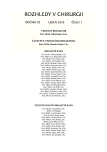-
Medical journals
- Career
Complications resulting from osteosynthesis in children after supracondylar fractures of the humerus
Authors: Ľ. Sýkora; R. Jáger; I. Béder; J. Trnka
Authors‘ workplace: Klinika detskej chirurgie LF UK a DFNsP, Bratislava, přednosta: Doc. MUDr. J. Trnka, CSc.
Published in: Rozhl. Chir., 2013, roč. 92, č. 1, s. 16-20.
Category: Original articles
Overview
Introduction:
The authors carried out the analysis of the causes for re-operations after percutaneous osteosynthesis of supracondylar fractures of the humerus in children.Materials and methods:
The authors evaluated the complications of osteosynthesis of supracondylar fractures in children hospitalized at the Clinic of Pediatric Surgery, University Hospital in Bratislava, for a 5-year period between 2007 and 2011. From the total number (395) of supracondylar fractures, 372 were treated as closed reduction and percutaneous transfixation.Results:
32 (8.6%) of supracondylar fractures that were treated as closed reduction and osteosynthesis were indicated for re-operation – 8 times for signs of lesion n. ulnaris, 7 times for migration of Kirschner wires, 17 times for non-anatomical status or osteosynthesis failure. In case of lesions of nervus ulnaris, Kirschner wires were eliminated from the ulnar side and replaced either with intramedullary descendently introduced Kirschner wire to the ulnar condyle (the first option) or with three divergent Kirschner wires from radial side (the second option). In case of failed osteosynthesis, reosteosynthesis was performed using three Kirschner wires (two parallel or divergent from the radial side and one through the medial epicondyle).Conclusion:
During the period monitored, the introduction of a differentiated approach in the treatment of supracondylar fractures of the humerus in children according to the type of fracture and the degree of displacement has significantly reduced the number of reoperations. Subsequently, it is important to notice that the decreased number of reosteosynthesis can be also assigned to the fact that the initial operation is not necessarily carried out as an urgent one (e.g. by a surgical team on night duty), but can be postponed and performed by an experienced traumatological team next day.Keywords:
supracondylar fracture of the humerus in children – complications – percutaneous fixation
Sources
1. Havránek P. Klasifikace suprakondylických zlomenín humeru u dětí. Acta Chir othop Traum čech 1998;65 : 277–288.
2. Topping RE, Blanco JS, Davis TJ. Clinical Evaluation of Crossed-Pin Versus Lateral-Pin Fixation in Displaced Supracondylar Hunerus Fractures. J. Pediatr. Orthop 1996;15 : 435–439.
3. D-Souza L, Dudeney S, Stephens M. Use of Two Lateral Kirschner Wires. J Pediatr Orthop 1996;16 : 678–679.
4. Zionts LE, McKellop HA, Hathaway R. Torsional Strenght of Pin Configuration Used to Fix Supracondylar Fractures of the Humerus in Children. J. Bone Joint Surg 1994;76–A:253–256.
5. Wilkins KE. The Operative Management of Supracondylar Fractures. Orthop. Clin N Amer 1990;21 : 269–289.
6. Vlahovič T, Bumči I. Biomechanical Evaluation of the Value of Osteosynthesis in Supracondylar Fracture of the Humerus Using Kirschner Pins in Children Eur J Pediatr Surg 2002;12 : 410–415.
7. Shim JJ, Lee Y S. Treatment of Completely Displaced Supracondylar Fractures of the Humerus in Children by Cross-Fixation With Three Kirschner Wires. J Pediatr Orthop 2002;22 : 12–16.
8. Bloom T, Robertson C, Mahar AT, Newton P. Biomechanical Analysis of Supracondylar Humerus Fracture Pinning for Slightly Malreduced Fractures. J Pediatr Orthop 2008;28 : 766–772.
9. Zenios M, Ramachandran M, Mine B, Little D, Smith N. Intraoperative Stability Testing of Lateral-Entry Pin Fixation of Pediatric Supracondylar Humeral Fractures. J Pediatr. Orthop 2007;27 : 695–702.
10. Brown IC, Zinar DM. Traumatic and Iatrogenic Neurological Complications after Supracondylar Humerus Fractures in Children. J. Pediatr. Orthop 1995;15 : 440–443.
11. Green DW, Widman RF, Frank JS, Gardner MJ. Low incidence of ulnar nerve injury with crossed pin placement for pediatric supracondylar humerus fractures using a mini-open technique. J. Orthop. Trauma 2005;19 : 158–163.
12. Zaltz I, Waters PM, Kasser JR. Ulnar Nerve Injury post Percutaneous Pinning. J Perdiatr Orthop 1996;16 : 567–569.
13. Michael SP, Stanislas MJC. Localization of the Ulnar Nerve During Percutaneous Wiring of Supracondylar Fractures in Children. Injury 1996;27 : 301–302.
14. Eberl R, Eder C, Smolle E, et al. Iatrogenic ulnar nerve injury after pin fixation and after antegrade nailing of supracondylar humeral fractures in children. Acta Orthop 2011;82 : 606–609.
Labels
Surgery Orthopaedics Trauma surgery
Article was published inPerspectives in Surgery

2013 Issue 1-
All articles in this issue
- Hilar cholangiocarcinoma (Klatskin tumor) – current treatment options
- Complications resulting from osteosynthesis in children after supracondylar fractures of the humerus
- The number of removed axillary sentinel lymph nodes and its impact on the diagnostic accuracy of sentinel lymph node biopsy in breast cancer
- Primary aortoduodenal fistula (PADF)
- Perspectives in Surgery
- Journal archive
- Current issue
- Online only
- About the journal
Most read in this issue- Hilar cholangiocarcinoma (Klatskin tumor) – current treatment options
- Complications resulting from osteosynthesis in children after supracondylar fractures of the humerus
- The number of removed axillary sentinel lymph nodes and its impact on the diagnostic accuracy of sentinel lymph node biopsy in breast cancer
- Primary aortoduodenal fistula (PADF)
Login#ADS_BOTTOM_SCRIPTS#Forgotten passwordEnter the email address that you registered with. We will send you instructions on how to set a new password.
- Career

